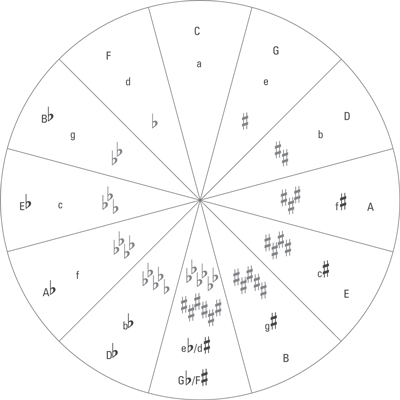The Circle of Fifths
The Circle of Fifths shows the relation between major keys and their relative minors. The major keys are indicated with capital letters, and their relative minors are in lowercase. Also shown here are the number of sharps or flats that you put in the key signature for each key.

Musical forms
Here’s a handy guide to the different parts in different kinds of compositions. From one-part form to pop song structure, everything you need to build a song based on form is in this list:
- One part form: A, AA, AAA, and so on
- Binary form: AB, AABB
- Ternary/tertiary form: ABA, AABA
- Arch form: ABCBA
- Sonata: ABA
- Rondo: ABACADA
- 8-bar blues: I, IV, I, VI, ii, V, I, V/I (turnaround)
- 2-bar blues: I, I, I, I, IV, IV, I, I, V, IV, I, V/I (turnaround)
- 16-bar blues: I, I, I, I, IV, IV, I, I, V, IV, V, IV, V, IV, I, V/I (turnaround)
- 24-bar blues: 8xI, 4xIV, Ix4, V, V, IV, IV, I, I, I, V/I (turnaround)
- Verse-chorus form (pop music): Intro ABACBCB
Building the seven Greek modes
There are seven main types of musical scales, also called modes. Each one consists of eight notes, combining whole and half steps in slightly different combinations to produce different feelings in the listener. Here are the steps in the seven modes:
- Ionian (the major scale): W(hole step), W, H(alf step), W, W, W, H
- Dorian: W, H, W, W, W, H, W
- Phrygian: H, W, W, W, H, W, W
- Lydian: W, W, W, H, W, W, H
- Mixolydian: W, W, H, W, W, H, W
- Aeolian (the minor scale): W, H, W, W, H, W, W
- Locrian: H, W, W, H, W, W, W
Major chord progressions
Some chords just sound right together, and some don’t. The following list shows you the tried-and-true sequences that always sound good when played together:
- I chords: Can appear anywhere in a progression
- ii chords: Lead to I, V, or vii chords
- iii chords: Lead to I, ii, IV, or vi chords
- IV chords: Lead to I, ii, iii, V, or vii chords
- V chords: Lead to I or vi chords
- vi chords: Lead to I, ii, iii, IV, or V chords
- vii chords: Lead to I or iii chords
Minor chord progressions
If you want to create spooky or sad music, building a song on minor chord progressions is a great way to start. Minor chord progressions sound just a little bit off, or melancholy, to the ear. Here are the most natural-sounding minor chord progressions:
- i chords: Can appear anywhere in a progression
- ii or ii chords: Lead to i, iii, V, v, vii, or VII chords
- III or III+ chords: Lead to i, iv, IV, VI, #vi, vii, or VI chords
- iv or IV chords: Lead to i, V, v, vii, or VII chords
- V or v chords: Lead to i, VI, or #vi chords
- VI or #v chords: Lead to i, III, III+, iv, IV, V, v, vii, or VII chords
- vii or VII chords: Lead to i chord
Rules of transposition
Although most music composition software programs can transpose instrument voices for you, if you want to do some transposition on paper with a pencil, it can get confusing. Here are some easy ways to approach each kind of transposition:
- E-flat instruments: Find the relative minor, make it major, and then write in that key. Notes are, therefore, moved up a sixth, or down a minor third.
- F instruments: Just add one sharp or subtract a flat from the key signature, and then write the music in the resulting key. Therefore, notation is moved up one perfect fifth from where originally written.
- B-flat instruments: Move everything up one whole tone. E-flat becomes F, F becomes G, and so on.

